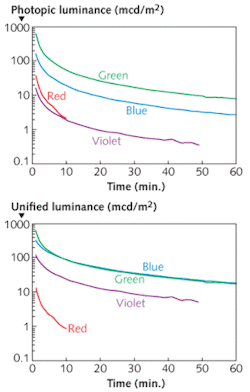
So-called persistent phosphors can glow for up to several hours after optical excitation. Combinations of persistent phosphors such as red, green, and blue that produce white light are being considered for safety illumination that works during power failures without any need for input power.1 The phosphors are characterized by measuring their photometric (that is, related to the perception of the human eye) output over time, which in practice means that the measurement units are based on the lumen or the candela.
However, the lumen and candela are defined in relation to daylight (photopic) vision, in which only the cones of the retina are participating. When the light gets low enough–such as could happen in power outages–the retina’s rods begin to take over. This situation, in which both rods and cones are working, is that of mesopic vision; at low-enough light levels, only the rods are functioning (scotopic vision). Because the rods’ response to color is quite different than that of cones, a phosphor combination that may appear white when bright could seem to be another color when dim.
Realizing this, scientists at Ghent University’s LumiLab (Ghent, Belgium), a laboratory that specializes in phosphors, decided to characterize persistent phosphors in a more true-to-life way.2
Unified luminance
The scientists decided to use a previously developed model that tries to be more realistic for mesopic vision than standard photometry.3 The researchers chose four persistent phosphors with different emission spectra that, in combination, span the visible spectrum. Although the phosphors had different crystal hosts, all relied on europium (Eu) as the emitter–the violet, blue, and green phosphors using Eu2+, and the red phosphor using Eu3+.
Their chosen model is based upon calculations for “unified luminance” (in cd/m2) that default to those for scotopic vision in very low light and photopic vision in bright light, while modeling true-to-life behavior in between; for example, as the light level is reduced, red becomes less well perceived relative to blue. This effect mirrors human biology: the rods in the retina, which take over from the cones in low light, are more sensitive to shorter wavelengths.
The researchers measured the persistent luminescence of the phosphors and then characterized the results both in units of photopic luminance (the standard method) and in units of unified luminance. The results were markedly different for the two cases (see figure). While the red and violet phosphors performed equally well under photopic conditions, the violet performed about ten times better than the red in mesopic conditions. In addition, while the green performed three times better than the blue in photopic conditions, both green and blue did equally well in mesopic conditions. The researchers confirmed these effects visually.
So in real life, this means that a persistent phosphor chosen for its high luminance in standard terms could be outperformed by a supposedly less-efficient phosphor under realistic conditions. Or, a balance of phosphors designed for white-light output may have to be rebalanced to truly produce white when the light is low.
The Ghent researchers emphasize that even the results of their research are a simplification due to a number of other factors, such as the differing time scales with which rods and cones adapt to low light, the varying proportions of rods and cones at different locations on the retina, and the approximate nature of the model used in the research. They will be carrying out more-detailed visual-perception tests in the future.
REFERENCES
- M. Saito et al., Optics Express 15, p. 1621 (2007).
- D. Poelman et al., Optics Express 17, p. 358 (2009).
- M.S. Rea et al., Lighting Research and Tech. 36, p. 85 (2004).
About the Author
John Wallace
Senior Technical Editor (1998-2022)
John Wallace was with Laser Focus World for nearly 25 years, retiring in late June 2022. He obtained a bachelor's degree in mechanical engineering and physics at Rutgers University and a master's in optical engineering at the University of Rochester. Before becoming an editor, John worked as an engineer at RCA, Exxon, Eastman Kodak, and GCA Corporation.
